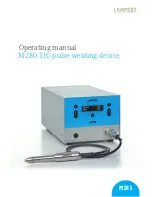
3 / 4
Connecting the cables
WARNING!
Risk of severe injuries or material damage to the device!
►
Make sure that this work is carried out only by qualifi ed specialist personnel.
1. Run the connecting cable of the heating mats and the sensor cable along the antenna carrier to the control unit.
2. Secure all cables with cable ties.
3. Run the cables from the bottom through the screw connection into the control device.
4. Run the mains cable from the bottom through the corresponding screw connection into the control device.
5. Test the heating for contact resistance and insulation resistance (R) before connecting the cables in the control
cabinet.
ESO 180 H
ESO 180 HL
Contact resistance
Target value
36.6 – 40.5 Ω (4x) 18.3 – 20.2 Ω (4x)
Actual value
Insulation resistance
Target value
> 999 MΩ
Actual value
De-installing the Refl ector Heating
1. Disconnect all cables leading to the control unit and the heating mats. Observe the “Installation and Safety Instruc-
tions” on page 2.
2. Use hot air to remove the heating mats (including adhesive residues) from the back of the antenna.
3. Install new heating mats on the back of the antenna as soon as possible (see “Installing the Refl ector Heating” on
page 2).
When the fi lm is removed, adhesive residues remain, which can only be removed completely with considerable eff ort.
You can glue the new heating mat over the adhesive residues.
2. Hold the heating mats on the antenna back panel to test their position. Observe the required position of the heating
mats (see fi gure on page 1, cable in the centre). Place the heating mats on the antenna back panel again and check if
they fi t correctly before gluing them on.
3. For gluing them on, hold the heating mats in place.
NOTICE!
Risk of material damage due to incorrect attachment of the heating mats!
If the heating mats are not attached to the antenna correctly, they can tear when the adhesive fi lm is removed.
►
Make sure that the heating mats are aligned correctly. To do so, place the heating mats fl ush with the outer edge
of the antenna and pay attention to the equal distance on the antenna bracket. Once the heating mats have
been glued on, they cannot be repositioned!
►
If possible, ask a second person to hold the heating mats.
4. Gradually remove the protective fi lm from the adhesive surface and press the heating mat fi rmly in place. Repeat this
process with all four heating mats.
5. Press the heating mats fi rmly to the antenna back panel. It can take up to 72 hours before the fi nal adhesive strength
is reached.
6. To prevent moisture and insects from entering the heating mat, adhere the mesh-rein-
forced aluminium foil all along the edges of the mat.
7. Clean the surface to be covered with the mesh-reinforced aluminium adhesive tape
(see 1.) to ensure the greatest possible adhesive strength of the white adhesive foil.
8. Cover the aluminium adhesive tape with the white adhesive foil. Stick the outer
contours of the heating mats with the elliptical segments according to the labelling
on the carrier foil and the other contours with the enclosed 75 mm wide adhesive foil.
oben
rechts
unten
rechts
oben
links
unten
links






















